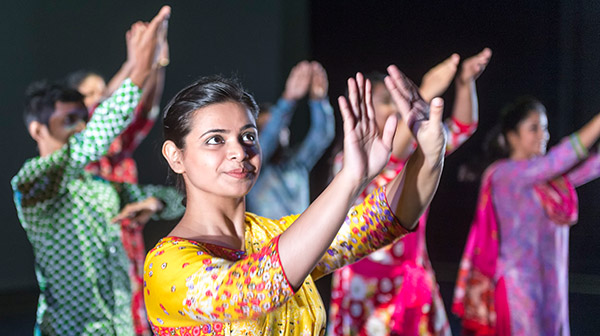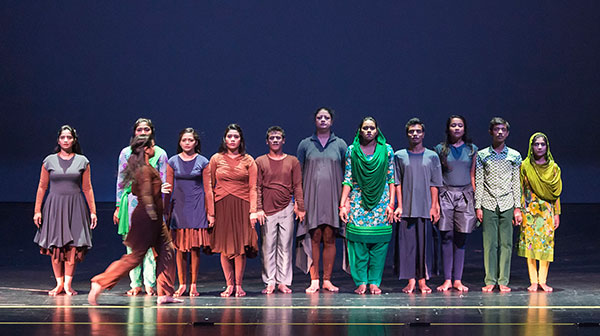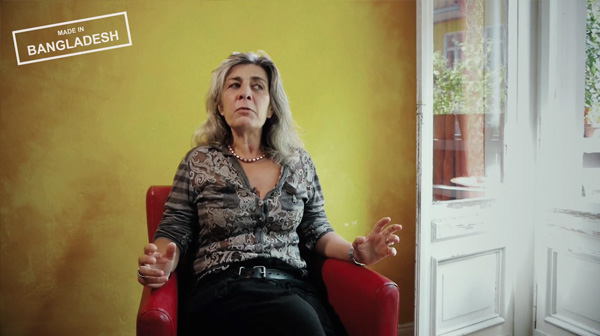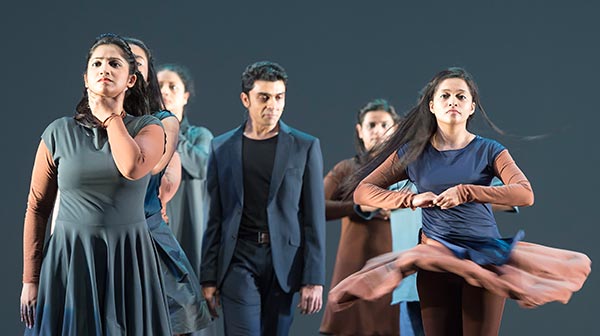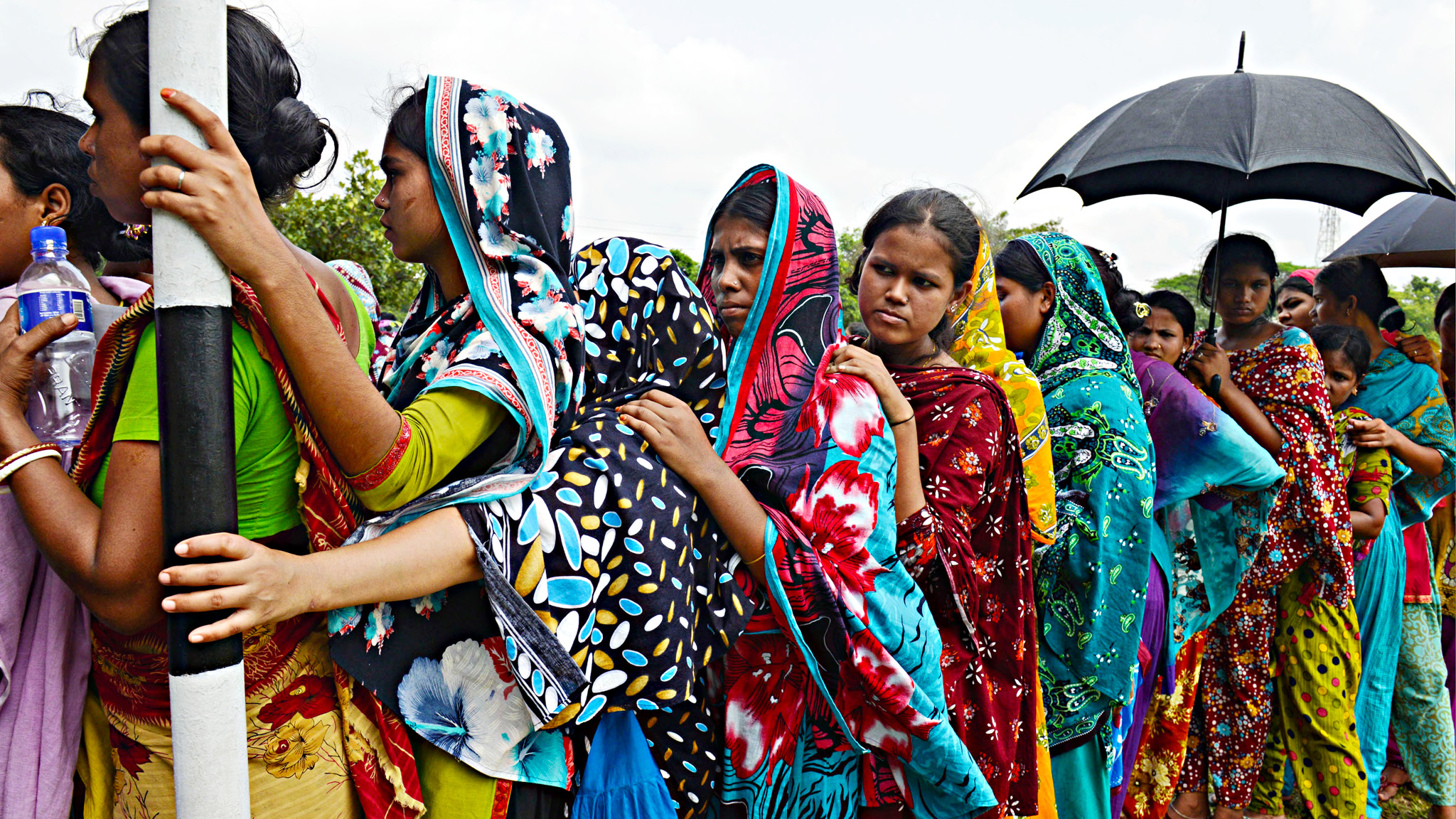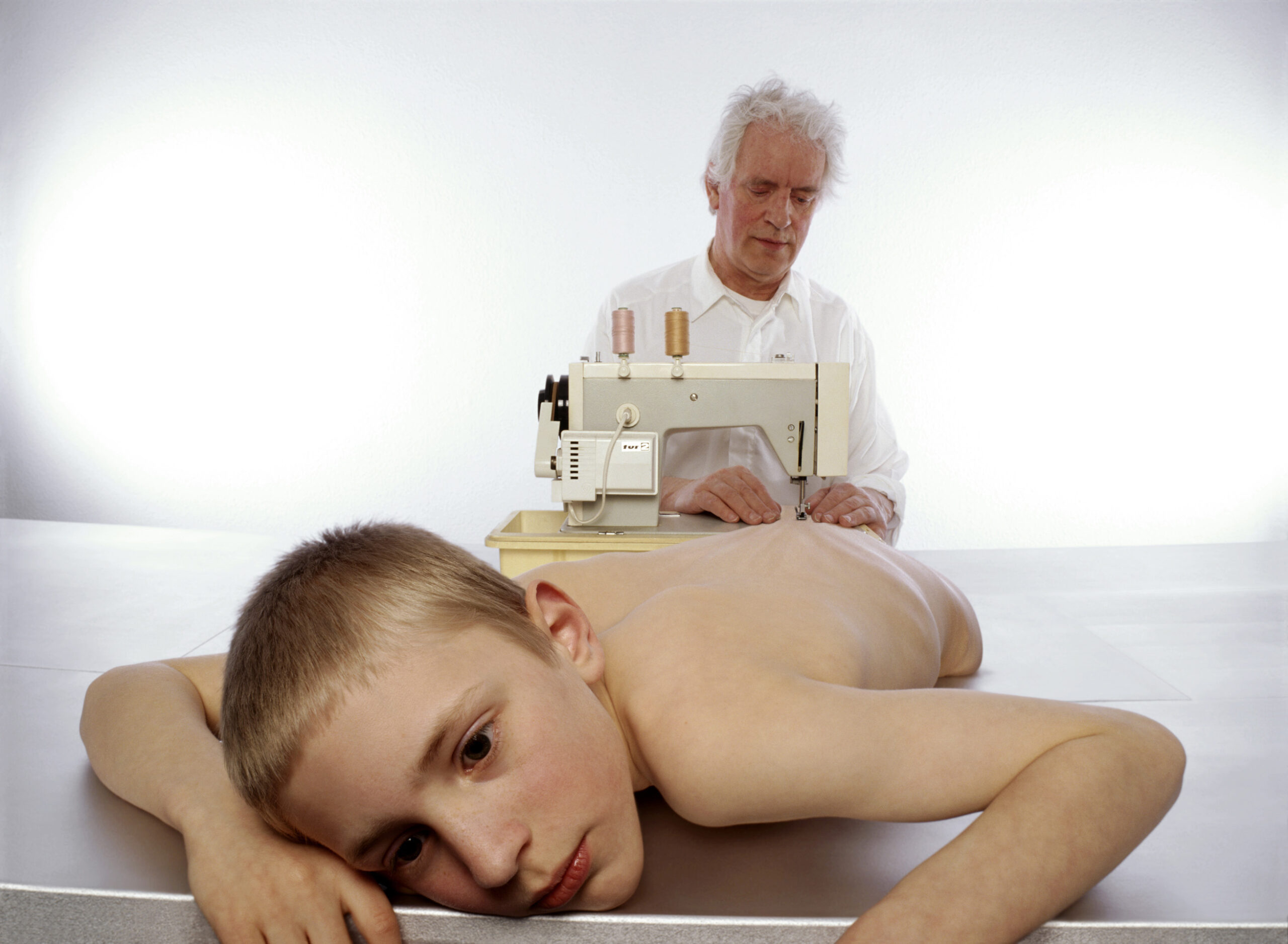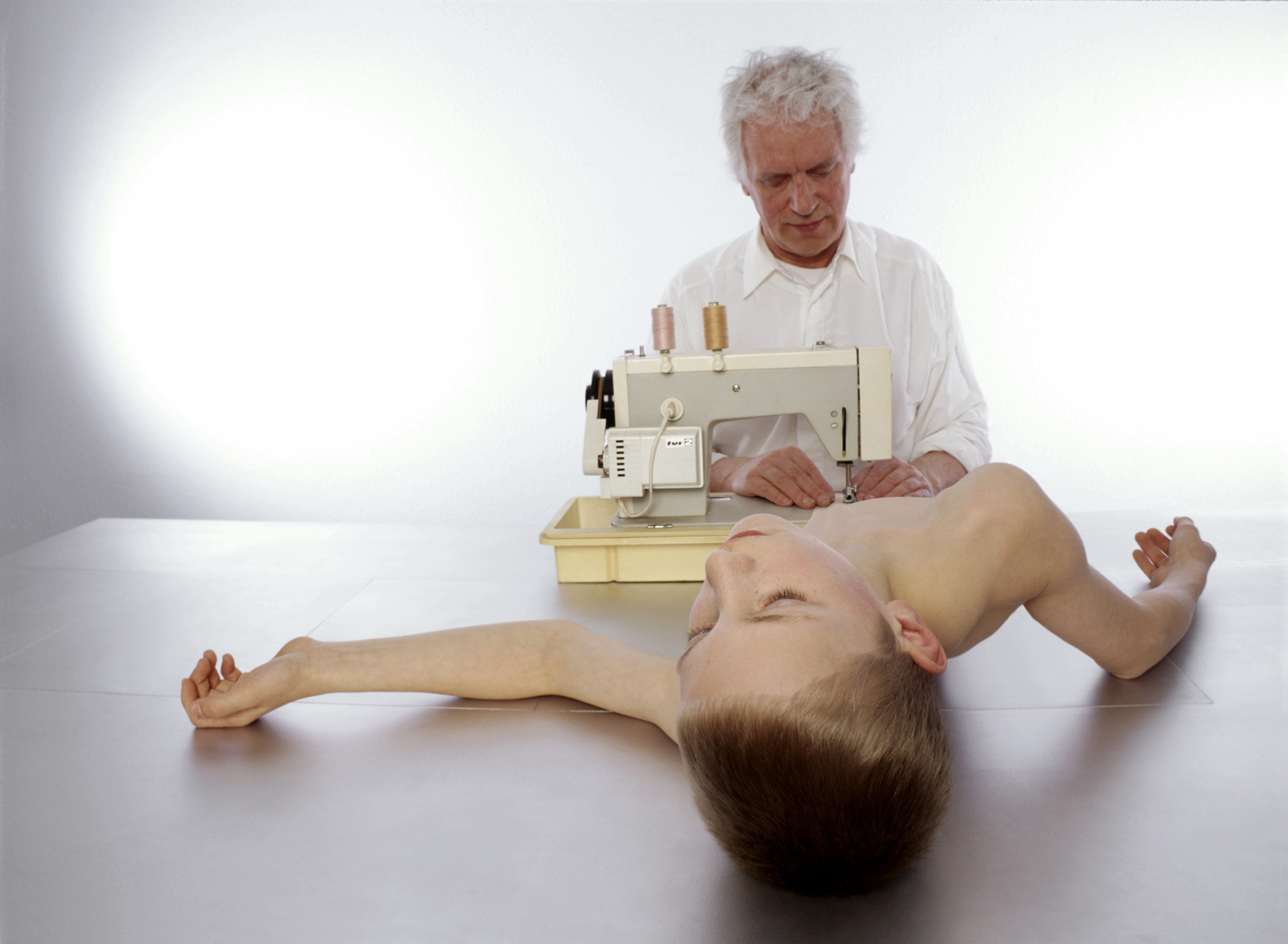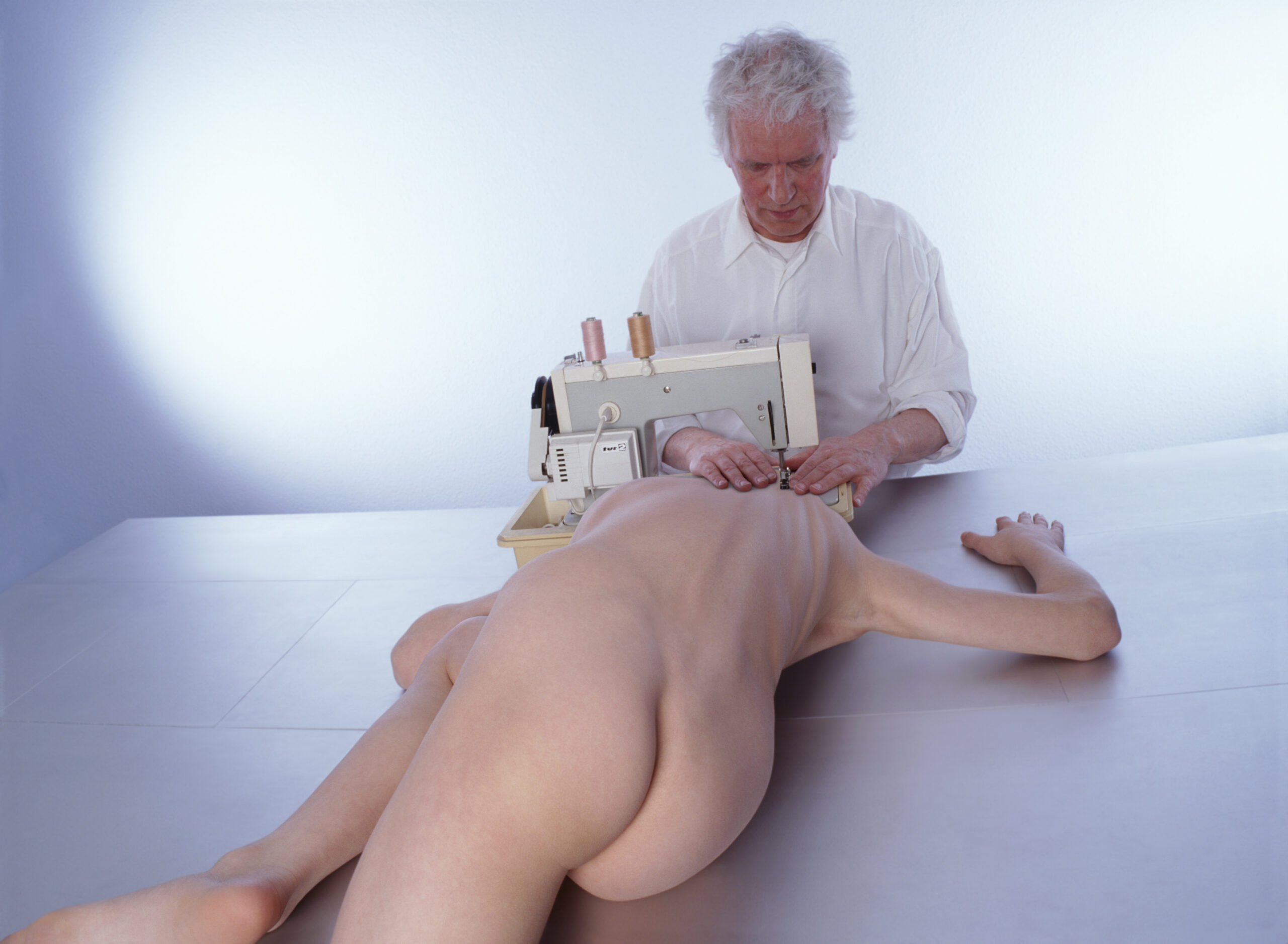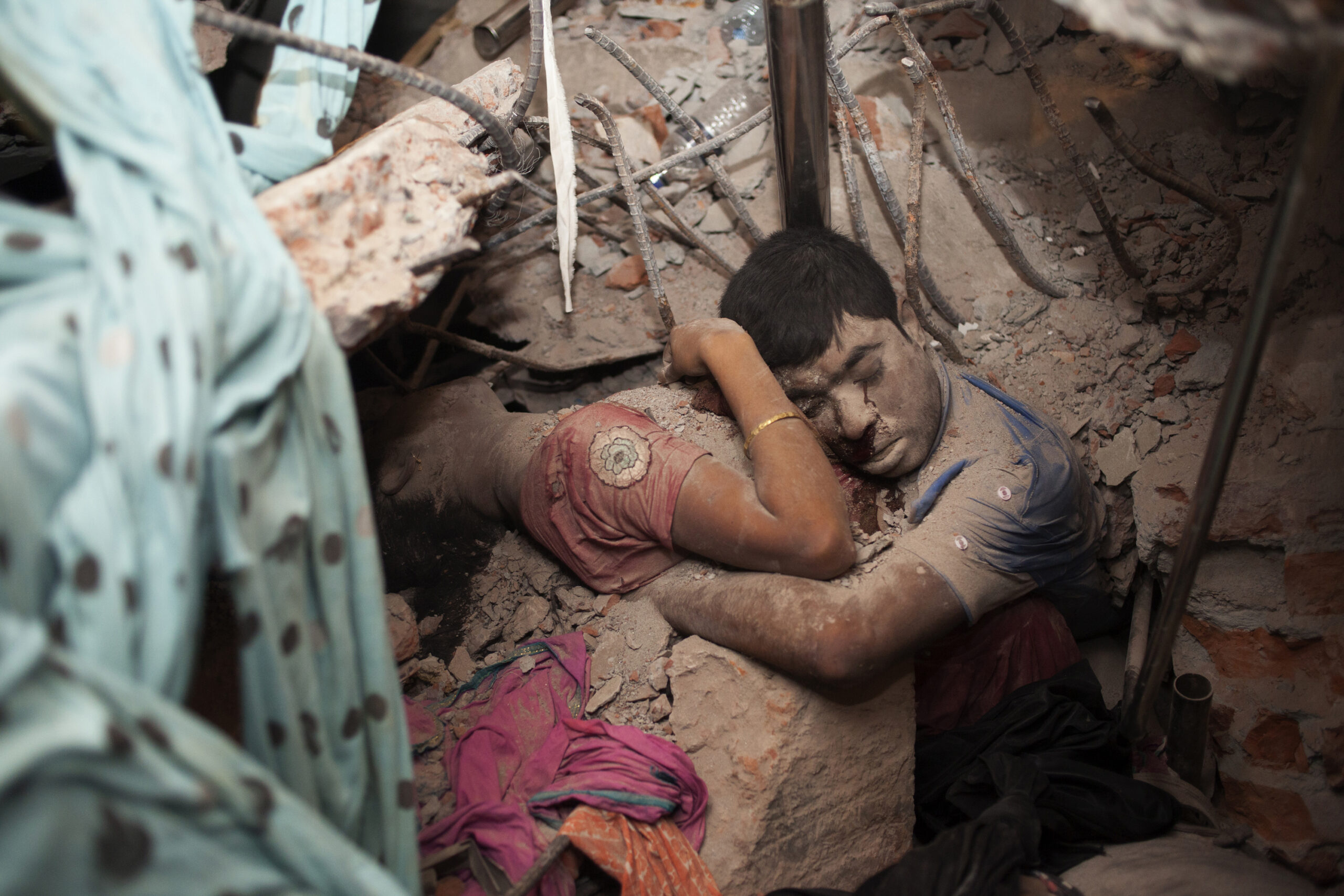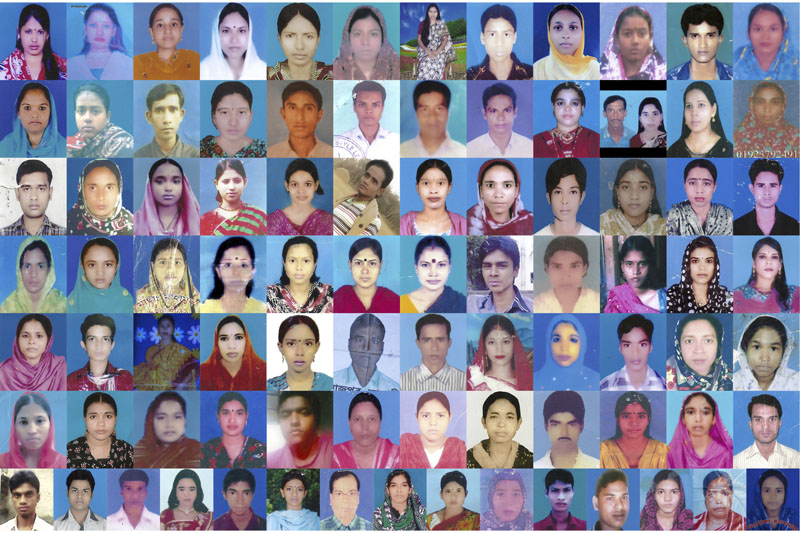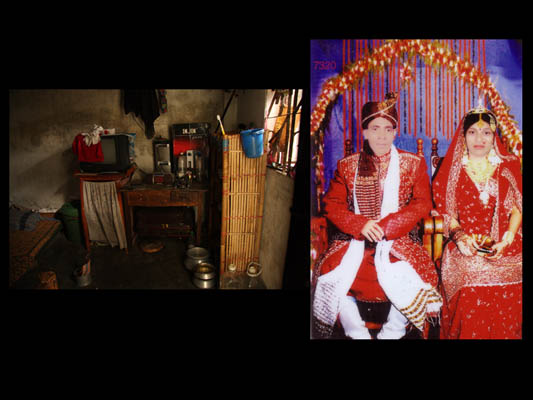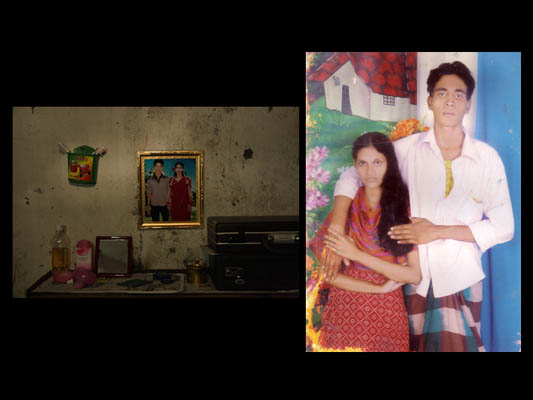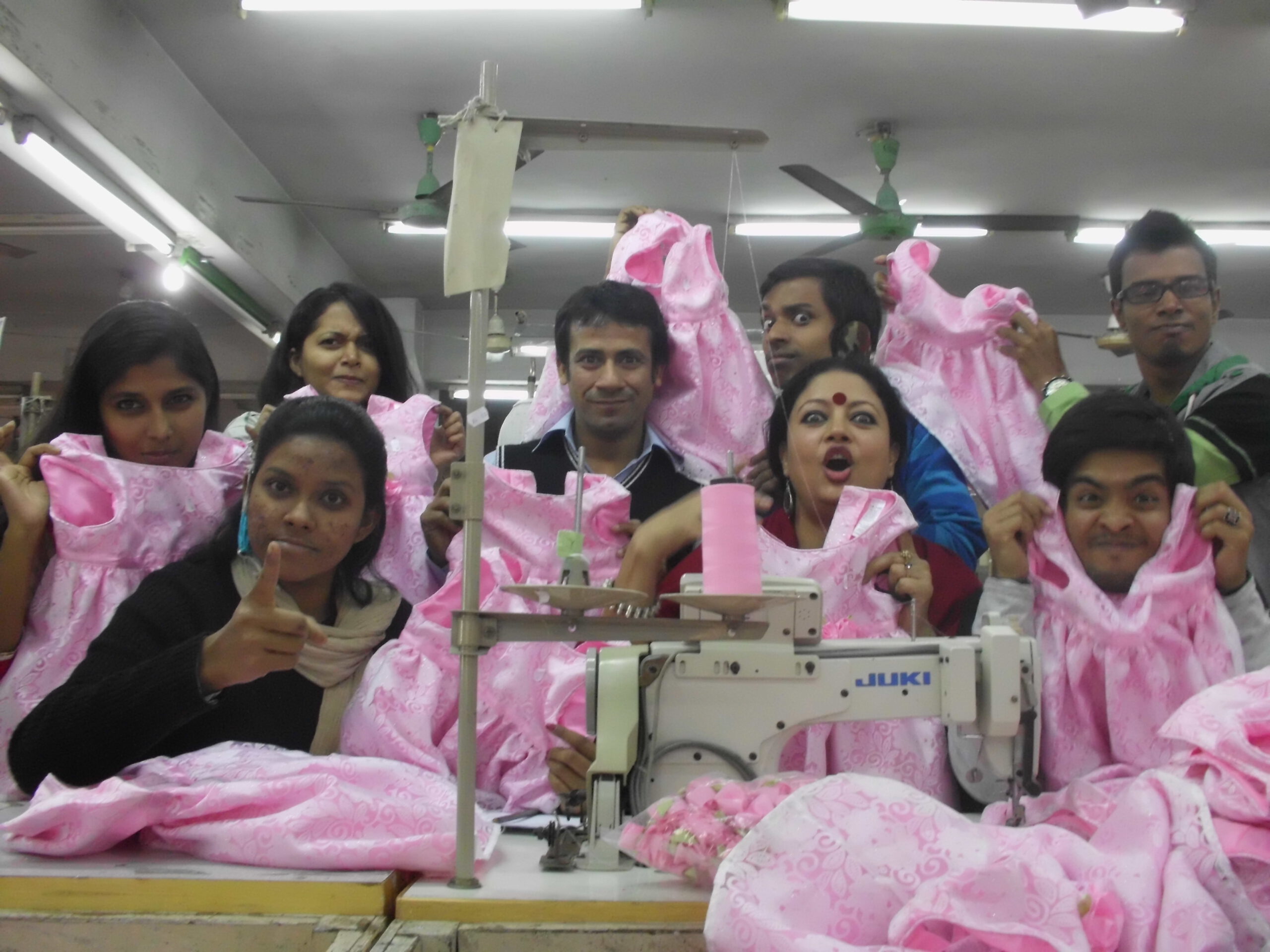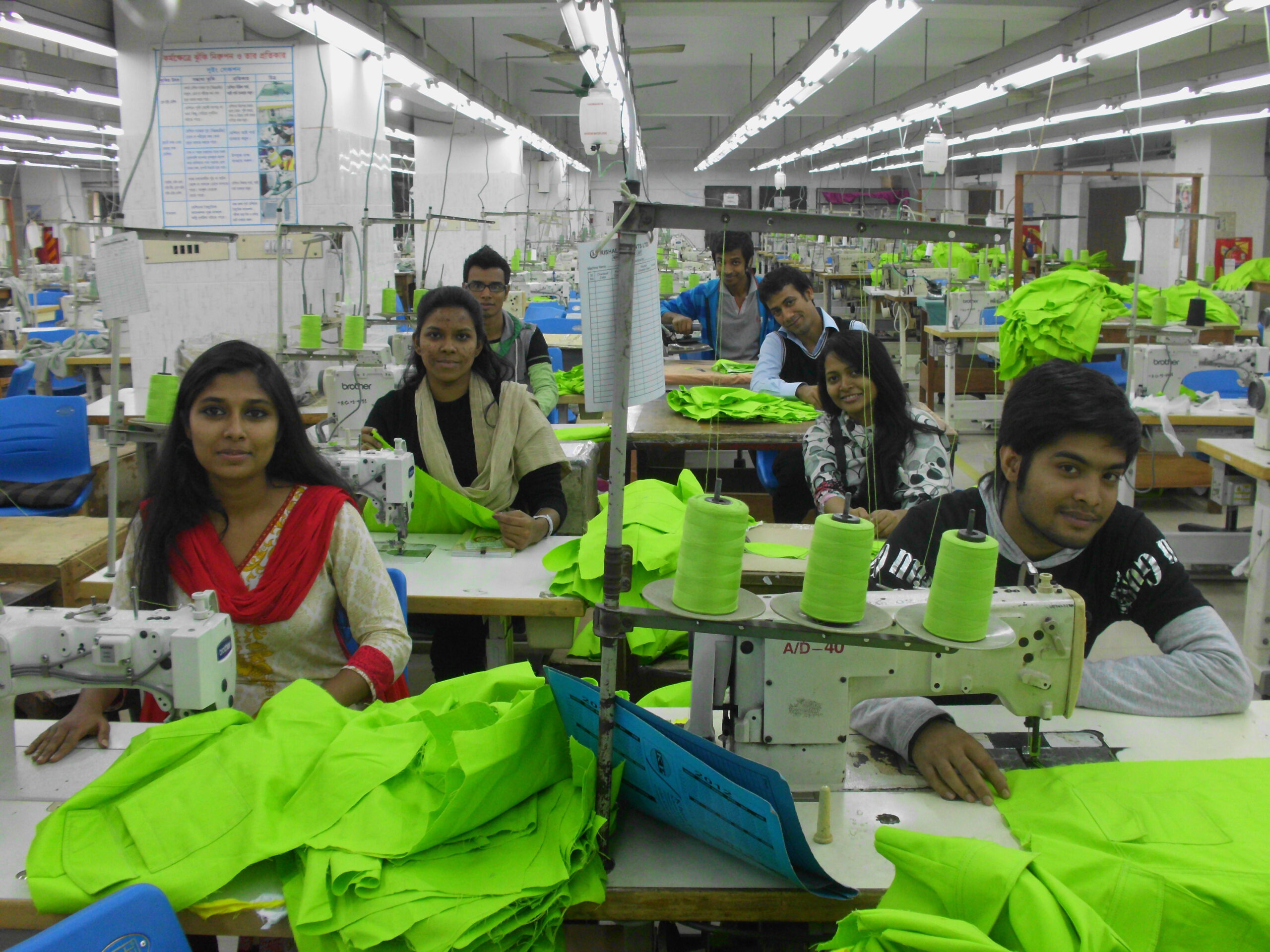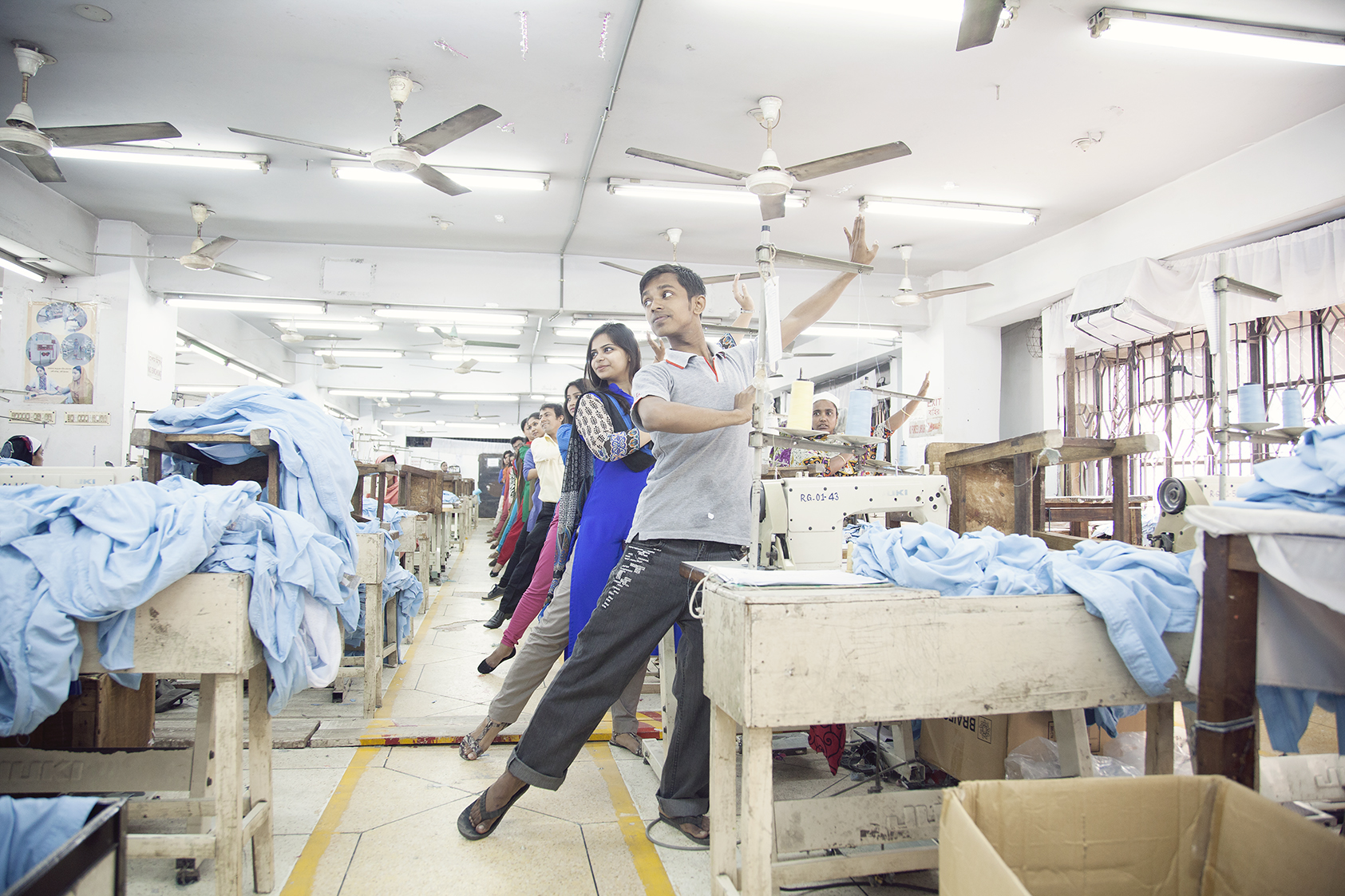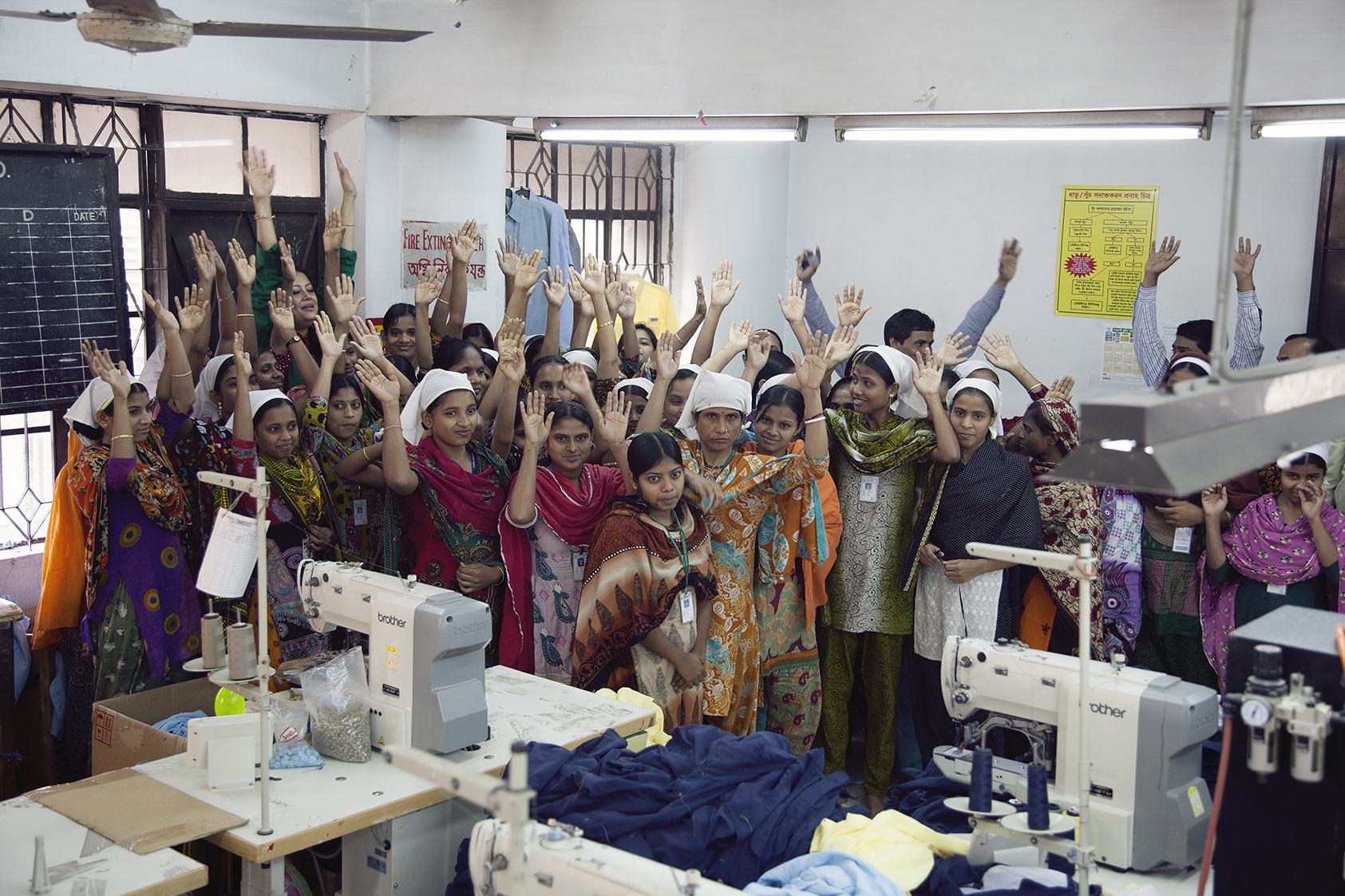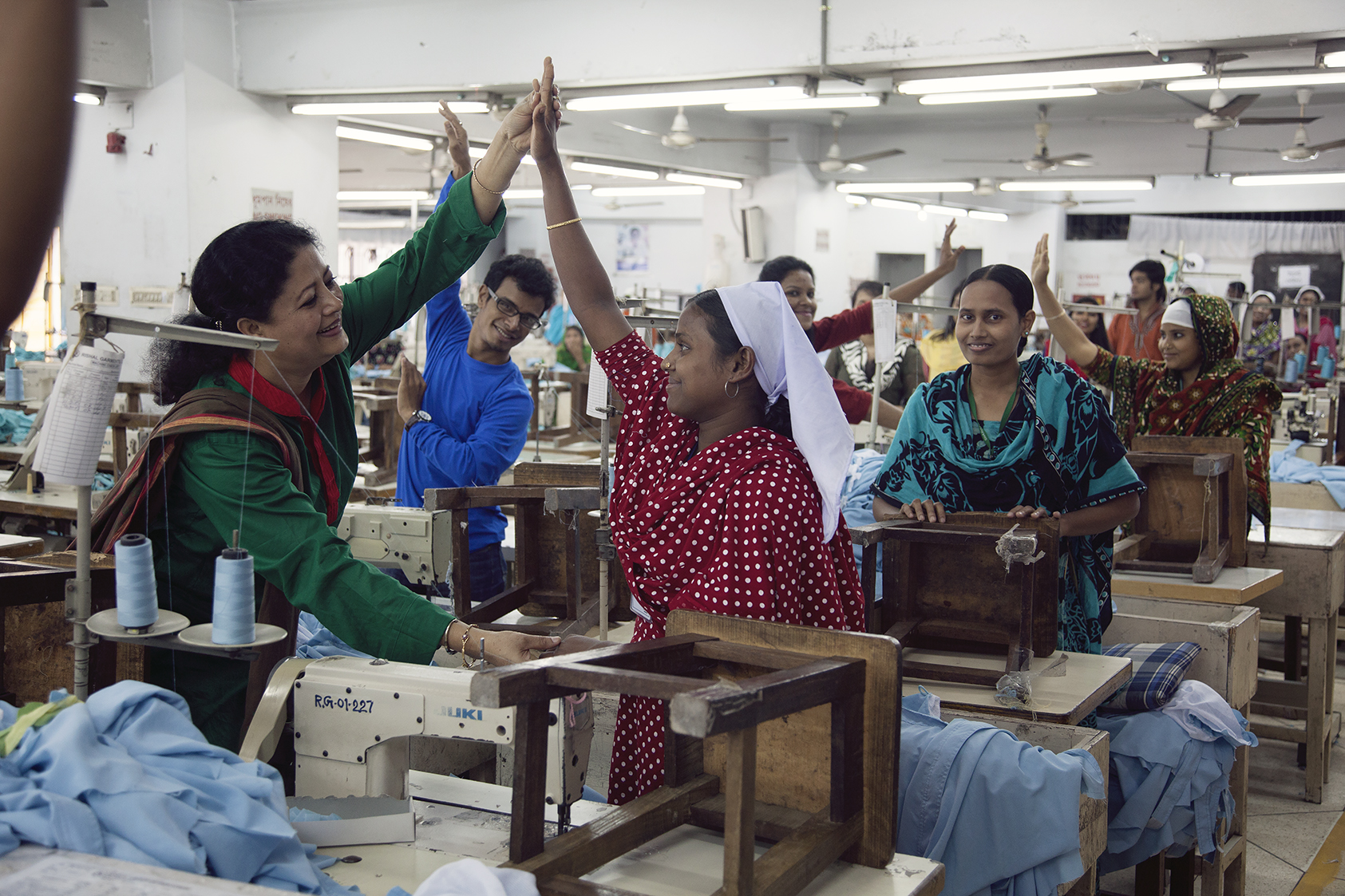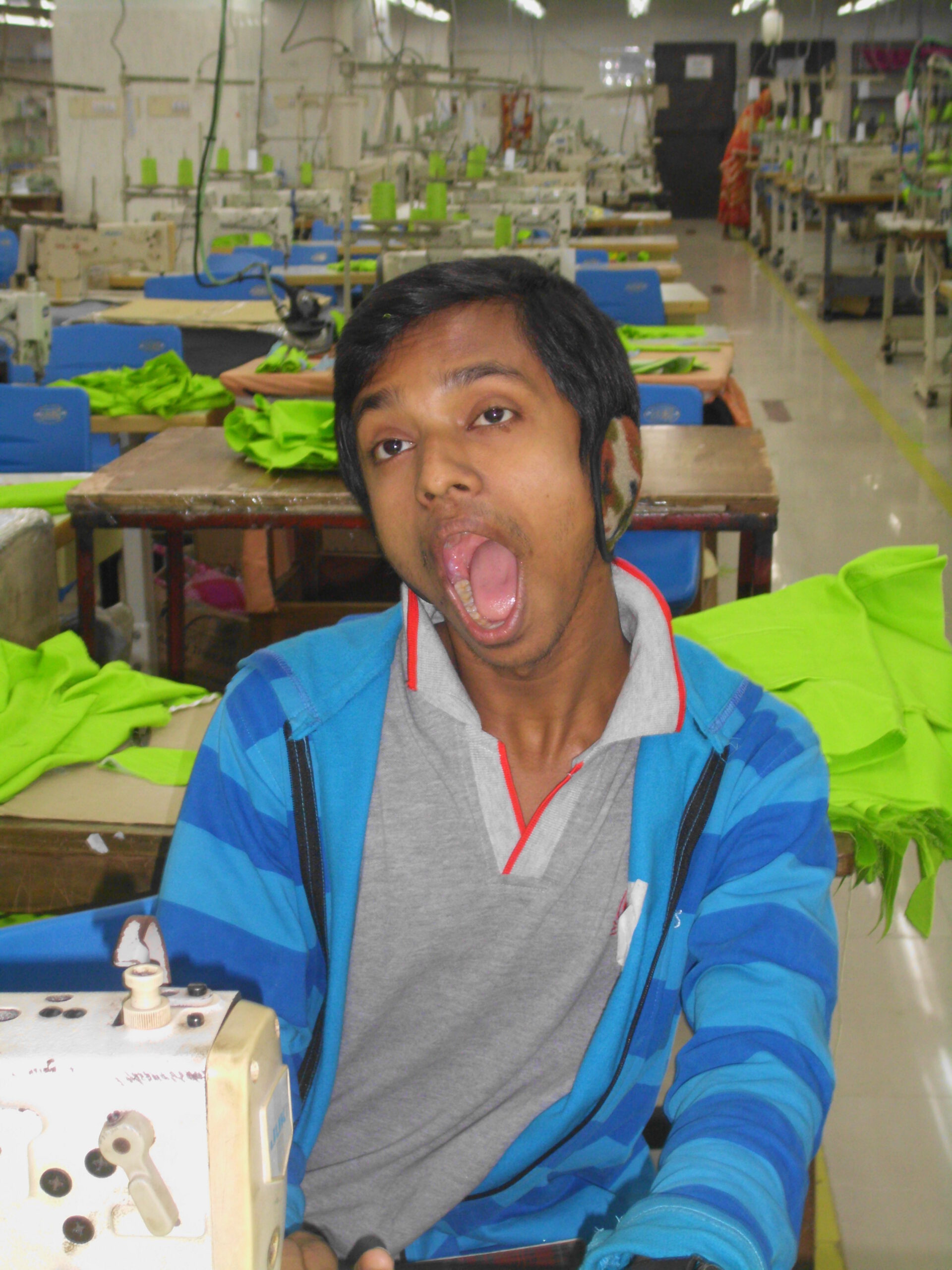Made in Bangladesh
– a sweatshop of dance -
2014
What lies behind the words “Made in Bangladesh”?
Helena Waldmann, with twelve Bangladeshi Kathak dancers, investigated Bangladesh’s infamous textile factories and translated into dance the working conditions that she found there. Waldmann stripped all the ornamentation from the north Indian Kathak dance, in which the colorfully clothed dancers’ feet hammer the floor. The kicking feet in competition with the stitching of clattering sewing machines, their pirouettes with the yarn bobbins. The quick rhythms of the Kathak make the exhaustion physically palpable. “I’m not physically strong enough for this work. I go through exploitation and abuse.” Statements like these and others from seamstresses appear at intervals projected on the backdrop. But the dancers proclaim into the microphone: “I am proud to be a part of the fashion industry – proud to be independent.” These too are sentences from the seamstresses and it is exactly these unresolved and irresolvable ambivalences that Helena Waldmann distilled in her researches and has put next to one another on the stage. What for one seamstress represents exploitation, for another means a first step to financial independence. The analogy with the European cultural sector and its self-exploitative structures is further sharpened in the second half of the piece. Quotes like: “Last year I danced 60 performances – this year 100. For the same money”, demonstrate clearly that European dancers too earn their money under precarious circumstances. “Made in Bangladesh” is a strong uncomfortable work, and in its consistency and physicality exactly the correct means to give artistic expression to the breakneck working conditions of the contemporary world.
«Made in Bangladesh» has been nominated for the German Theatre Prize THE FAUST
The piece combines dance with a political message - a power package that does not leave any body indifferent.
a production by Helena Waldmann and ecotopia dance productions
In collaboration with
SHADHONA – A Center for the Advancement of Southasian Culture (BD) and Goethe-Institut Bangladesh
co-produced with Theater im Pfalzbau Ludwigshafen (D), Les Théâtres de La Ville de Luxembourg (L), Goethe-Institut Bangladesh (BD), Burghof Lörrach (D), Forum Freies Theater Düsseldorf (D), Tollhaus Karlsruhe (D), Kurtheater Baden (CH)
Funded by the German Federal Cultural Foundation.
Special thanks to Nazma Akhter, to the 13 workers as mentors of the dancers and to Green Ink from Dhaka.
Official Trailer – Made in Bangladesh | 4 min.
Trailer – Bolzano Danza Festival | 1:26 min.
Helena Waldmann – The Beginning (German) | 5 min.
Official full length video – Made in Bangladesh | 70 min. | only with password, ask me
set design
direction
choreography
Helena Waldmann
co-choreography
Vikram Iyengar
dance
Munmun Ahmed
Shammy Akter
Pritha Shareen Ferdous
Masum Hossain
Urme Irin
Mela Lamiya
Trina Mehnaz
Hanif Mohammad
Tumtumi Nuzaba
Bishwazit Sarkar
Shoma Sharmin
Labonno Sultana
video dancer
Brit Rodemund
composition/music production
Daniel Dorsch
musical director/music production
Hans Narva
video
Anna Saup
light design
Herbert Cybulska
costumes
Hanif Kaiser
Judith Adam
rehearsal director
Anika Bendel
dramaturgical consultant
Dunja Funke
video post production
Michael Saup
creative pattern cutting
Tina Luther
projected photos
Taslima Akhter
Rahul Talukdar
Margi Geerlinks
project management
Claudia Bauer
technical staff
Carsten Wank
Stephan Wöhrmann
Roman Fliegel
fotos
Wonge Bergmann
duration
77 minutes
Touring
Premiere:
2014, NOV 26
Theater im Pfalzbau Ludwigshafen (D)
2014
NOV 29+30
FFT, Düsseldorf in cooperation with Tanzhaus NRW (D)
DEC 3
Tollhaus Karlsruhe (D)
DEC 6
Les Théâtres de la Ville de Luxembourg (L)
DEC 9
Burghof Lörrach (D)
DEC 11
Kurtheater Baden (CH)
DEC 14
Staatstheater Darmstadt (D)
DEC 16
Tafelhalle Nürnberg (D)
DEC 20+21
Theaterhaus Jena (D)
2015
JAN 13
6th International Festival of Kerala KT Muhammed Theatre (India)
JAN 17
Ignite ! Festival of Contemporary Dance Kamani Auditorium (India)
JAN 20
NCPA National Centre for the Performing Arts Mumbai (India)
JAN 22
Science City Main Auditorium, Kolkata (India)
JAN 26
Shilpakala Academy, Dhaka (Bangladesh)
MAY 9+10
DANCE 2015 Festival Munich (D)
SEPT 5+6
Norrlands Operan Umea (Sweden)
SEPT 11+12
Festival TanzTheater International Hannover (D)
OCT 17
15. Kemptener Tanzherbst (D)
OCT 19
Forum Leverkusen (D)
OCT 21
Zuiderstrandtheater Den Haag (NL)
OCT 24
Forum am Schlosspark Ludwigsburg (D)
OCT 28
Kurtheater Bad Homburg (D)
2016
JULY 17
Nowy Teatr Warsaw (PL)
JULY 20
Festival Bolzano Danza (I)
Film of Made in Bangladesh in exhibitions
2016, APRIL 15 – JUNE 24
Haus der Brandenburgisch-Preußischen Geschichte, Potsdam (D) /
As part of the special exhibition: uni-form? Body, Fashion and Work Made to Measure.
2017, OCT 26 – JUNE 5
Textilmuseum St. Gallen (CH) – as part of the exhibition: Fast fashion. The Dark Side of Glamour
2018, OCT 18 – 2019, FEBR 19
Rautenstrauch-Joest-Museum – Kulturen der Welt, Köln (D) – as part of the special exhibition: Fast Fashion
photo by Ismail Ferdous
Conversations
english
Stuttgarter Nachrichten | 28.11.2014
by Andrea Kachelriess
Ever more, Ever cheaper >
How do we deal with human resources? Dance director Helena Waldmann looked around Bangladesh’s textile factories for her new production.
Beautiful dress. Unfortunately „Made in Bangladesh“ is on the label. Is it still allowed to buy it? After several catastrophes, the situation of the seamstresses there is well known. They work in overcrowded, insecure buildings, sew on a piecework basis and earn so little in the end that it is hardly enough for the bare essentials.
More than 1100 textile workers died a year ago when a factory building collapsed in a suburb of Bangladesh’s capital Dhaka. But it’s not just news like this that has sparked director Helena Waldmann’s interest in the sewing factories. „Made in Bangladesh“ is the title of her new play, which will be premiered in Dhaka in the fall and will be performed in Ludwigshafen. It wants to look behind the scenes of exploitation in order to better understand its mechanisms. Because, as Helena Waldmann knows, exploitation is not a foreign word on German dance stages either.
How does one get six female performers to dance on stage when the highest commandment of their country is that women hide their bodies? Waldmann packed her Iranian protagonists in tents, and got them to speak and dance through and within them. The director cleverly demonstrated back then that our projections do not always match up with real events. And thus, she pilloried our Eurocentrism as well as the paternalism of a totalitarian system.
The situation of seamstresses in Bangladesh too has two sides to it, as a conversation with Helena Waldmann quickly makes clear. For her piece “Made in Bangladesh” she researched the textile factories on site. “I saw good and bad factories. In the good ones, the seamstresses are poor, to be sure, but proud. They say that they are paragons for many women. They are happy and through their needlework no longer at the edge of society, rather in the centre: it’s the millions of seamstresses who are pushing the Bangladeshi economy strongly forward. In addition, they are proud to have gained a certain independence and to be able to support their families.”
In the bad factories, Helena Waldmann continues, the people are “dead tired, ill, abused, insulted, sometimes beaten, and without any rights.” To criticize their situation is nevertheless taboo, because they are afraid that the industry could migrate to countries where production is even cheaper. “The seamstresses told me: please don’t boycott our products. We really want and need this work.”
So, should one after all buy a dress “Made in Bangladesh”? Helena Waldmann advises the consumer to use their power and their intelligence: “We have to pay more heed to what it is we really need. Don’t buy in bulk, be rather picky when you shop! That also means that one must look at the conditions under which a piece of clothing is made. Do I want to look good at the cost of other people, or rather be able to wear something with peace of mind?”
But is that so easy to ascertain in the shop? Helena Waldmann doesn’t allow excuses. “The long chain of involved parties makes it easy to shift the blame onto others. But that is not the right way. We have to ask ourselves: can it be that a t-shirt costs one and a half Euros? No? Then I must as a consumer take on responsibility through my buying decision.”
During her researches in Bangladesh Helena Waldmann experienced that to gain insight into the textile factories is not at all easy. “Many owners wouldn’t let us in. Or if they did, then only after sounding the warning: Attention, buyers coming! After this everyone acted differently and in the washrooms there was soap and hand towels.”
What she did see was the extreme pressure on the part of the seamstresses, the factory owners, and the buyers. “It’s about nothing other than: ever more, ever faster, ever cheaper. Should the sewing machines not hum to the prescribed time, then the piecework is in danger”, observed Helena Waldmann. “Large display boards show the hourly output of each line of machines and stoke up competition.”
Most of the seamstresses live in slums. “Many say: thanks to catastrophes, pressure has grown on manufacturers, there are more controls and also advances, but it is not enough, when only the situation in the factories gets better, wages must also rise so that we don’t have to live any longer below the poverty line.”
At the moment, Helena Waldmann is working on translating her research on the theme of exploitation into dance. For this she found 13 Kathak dancers in Dhaka. This Indian dance style, she explains, needs stiff dancers. “The dance plays out in the feet. The rhythmic stamping reminds one of the clatter of sewing machines. The feet of the dancers are like the needles stitching the cloth.” With the help of projections dance and sewing are intended to overlap. Conversations with seamstresses, who visited the dancers in their studio, were integrated into the work.
The pressure, which rests upon seamstresses in Bangladesh, is all too familiar to Helena Waldmann. “Optimization, efficiency: it is much the same for dancers in Germany. They are supposed to work ever more and ever cheaper, because appreciation is lacking and less and less money is available for dance productions. Some sew, others dance themselves to exhaustion.” Her piece will also recount this, and she finds more than enough parallels between dancers and seamstresses: “In both cases the exploitation is at a maximum. Anyone who opens their mouth and complains is out of a job.”
Just as the consumer can boycott an unfairly produced t-shirt, Helena Waldmann wants them to be more alert when going to the theatre: “The public must finally realize the conditions under which art is created. Thankfully more and more stage artists are speaking out.” She advises dance professionals that when their grants are cut, not simply to continue working as usual. “Then I have to keep applying for funds, until I can realize a production in good faith. Or there will only be half of the piece.” Thanks to funds from the Kulturstiftung des Bundes, Helena Waldmann has been able to produce “Made in Bangladesh” fairly.
german
Stuttgarter Nachrichten | 10.05.2014
von Andrea Kachelriess
Ever more, Ever cheaper >
Wie gehen wir mit menschlichen Ressourcen um? Die Tanzregisseurin Helena Waldmann hat sich für ihre neue Produktion in den Textilfabriken von Bangladesch umgeschaut.
Schönes Kleid. Leider steht „Made in Bangladesh“ auf dem Etikett. Darf man das noch kaufen? Nach mehreren Katastrophen ist die Situation der Näher dort hinreichend bekannt. Sie arbeiten in überfüllten, unsicheren Gebäuden, sie nähen im Akkord und verdienen am Ende so wenig, dass es fürs Nötigste kaum reicht.
Mehr als 1100 Textilarbeiter starben vor einem Jahr, als in einem Vorort von Bangladeschs Hauptstadt Dhaka ein Fabrikgebäude einstürzte. Aber es sind nicht allein Meldungen wie diese, die das Interesse der Regisseurin Helena Waldmann an den Nähereien geweckt haben. „Made in Bangladesh“ heißt ihr neues Stück, das nach der Premiere in Dhaka im Herbst nach Ludwigshafen kommt. Es will hinter die Kulissen der Ausbeutung blicken, um ihre Mechanismen besser zu verstehen. Denn Ausbeutung ist, wie Helena Waldmann weiß, auch auf deutschen Tanzbühnen kein Fremdwort.
Wer Helena Waldmanns Arbeiten kennt, kann sich gut vorstellen, dass dieses Thema bei ihr gut aufgehoben ist. Wenige Choreografen zeigen wie sie, dass Tanz politisch sein kann, ohne ästhetische Prinzipien aufzugeben. Am Nerv der Zeit liegen ihre Themen allemal, vor zehn Jahren traf sie mit „Letters from Tentland“, einem in Teheran erarbeiteten Stück zum Verschleierungsgebot des Islam, ins Schwarze. Wie bringt man sechs Darstellerinnen auf der Bühne eines Landes zum Tanzen, in dem das Verbergen des Körpers für Frauen oberstes Gebot ist? Waldmann verpackte ihre iranischen Protagonistinnen in Zelte, ließ sie mit und in diesen tanzen und sprechen. Klug führte die Tanz-Regisseurin damals vor, dass sich unsere Projektionen nicht immer mit den realen Begebenheiten decken. Und so stellte sie unseren Eurozentrismus genauso an den Pranger wie die Bevormundungen eines totalitären Systems.
Auch die Situation der Näher in Bangladesch hat zwei Seiten, wie ein Gespräch mit Helena Waldmann schnell zutage fördert. Sie hat für ihr Stück „Made in Bangladesh“ in den Textilfabriken vor Ort recherchiert. „Ich habe gute und schlechte Fabriken gesehen. In den guten sind die Näherinnen zwar arm, aber stolz. Sie sagen, sie seien für viele Frauen Vorbilder. Sie sind glücklich und stehen durch die Näherei nicht mehr am Rand der Gesellschaft, sondern sind im Zentrum: Es sind die Millionen nähenden Frauen, die die Wirtschaft Bangladeschs stark vorantreiben. Zudem sind sie stolz, eine gewisse Unabhängigkeit erlangt zu haben und ihre Familien unterstützen zu können.“
In den schlechten Fabriken, erzählt Helena Waldmann, seien die Leute „todmüde, krank, missbraucht, beschimpft, manchmal geschlagen und rechtlos“. Kritik an ihrer Situation ist für Textilarbeiter jedoch tabu, da sie fürchten, die Industrie könne in Länder abwandern, die noch billiger produzieren. „Die Näherinnen sagten zu mir: Bitte boykottiert unsere Produkte nicht. Wir wollen und brauchen diese Arbeit dringend.“
Soll man das Kleid „Made in Bangladesh“ also doch kaufen? Helena Waldmann rät dem Verbraucher, seine Macht und seinen Kopf zu benutzen: „Wir müssen mehr darauf achten, was wir überhaupt brauchen. Nicht in Masse, sondern ausgesucht einkaufen! Das heißt auch, dass man darauf schaut, unter welchen Umständen ein Kleidungsstück hergestellt wurde. Will ich auf Kosten anderer gut aussehen oder etwas mit guten Gewissen tragen können?“
Doch lässt sich das im Laden so leicht feststellen? Ausreden lässt Helena Wald- mann nicht gelten. „Die lange Kette der Beteiligten macht es leicht, die Schuld immer auf andere zu schieben. Aber das ist nicht der richtige Weg. Wir müssen uns fragen: Kann es sein, dass ein T-Shirt 1,50 Euro kostet? Nein? Dann muss ich als Verbraucher durch meine Kaufentscheidung Verantwortung übernehmen.“
Bei ihrer Recherche in Bangladesch erlebte Helena Waldmann, dass Einblick in die Textilfabriken gar nicht so leicht ist. „Viele Besitzer ließen uns nicht rein. Oder wenn doch, dann nur nach der lauten Warnung: Achtung, Käufer kommen! Danach haben sich alle anders verhalten und im Waschraum lagen Seife und Handtücher.“
Gesehen hat sie extremen Druck, aufseiten der Näher, der Fabrikbesitzer und der Käufer. „Es geht um nichts anderes als: immer mehr, immer schneller, immer billiger. Wenn die Nähmaschinen nicht im vorgegebenen Takt surren, ist der Akkord in Gefahr“, hat Helena Waldmann beobachtet. „Große Tafeln zeigen den stündlichen Output einer Nähreihe und heizen die Konkurrenz an.“
Die meisten Näher wohnen in Slums. „Viele sagen: Durch die Katastrophen ist der Druck auf die Hersteller gewachsen, es gibt mehr Kontrollen und auch Fortschritte, aber es reicht nicht, wenn nur die Situation in den Fabriken besser wird, auch die Löhne müssen steigen, damit wir nicht weiter unter dem Existenzminimum leben müssen.“
Derzeit arbeitet Helena Waldmann daran, ihre Recherchen zum Thema Ausbeutung in Tanz umzusetzen. 13 Kathak-Tänzer hat sie dafür in Dhaka gefunden. Dieser indische Tanzstil, erklärt sie, wolle steife Tänzer. „Der Tanz spielt sich in den Füßen ab. Das rhythmische Stampfen erinnert an das Rattern der Nähmaschinen. Die Füße der Tänzer sind wie die Nadeln, die den Stoff ste- chen.“ Mit Hilfe von Projektionen sollen sich Tanz und Nähen überlagern. Gespräche mit Nähern, die die Tänzer im Proberaum besuchten, fließen in die Arbeit mit ein.
Den Druck, der auf den Nähern in Bangladesch ruht, kennt Helena Waldmann zu gut. „Optimierung, Effizienz: Dasselbe findet in Deutschland bei Tänzern statt. Sie sollen immer mehr und immer billiger arbeiten, weil es an Wertschätzung fehlt und für Tanzproduktionen immer weniger Geld zur Verfügung steht. Die einen nähen, die anderen tanzen bis zur Erschöpfung.“ Auch davon will ihr Stück erzählen, Parallelen zwischen Tänzern und Nähern gibt es für sie genügend: „In beiden Fällen ist die Ausbeutung maximal. Und wer den Mund aufmacht und sich beschwert, ist seinen Job los.“
So wie der Verbraucher das unfair produzierte T-Shirt boykottieren kann, möchte ihm Helena Waldmann mehr Aufmerksamkeit beim Theaterbesuch zumuten: „Das Publikum muss endlich wahrhaben, unter welchen Bedingungen Kunst entsteht. Zum Glück gibt es immer mehr Bühnenkünstler, die den Mund aufmachen.“ Tanzschaffenden rät sie, bei einer Kürzung der Zuschüsse nicht einfach wie gehabt weiterzuarbeiten. „Dann muss ich so lange Mittel beantragen, bis ich eine Produktion mit gutem Gewissen realisieren kann. Oder es gibt eben nur die Hälfte vom Stück.“ Dank Mitteln der Bundeskulturstiftung konnte Helena Waldmann „Made in Bangladesh“ fair produzieren.
Press
english
TANZ | 2015, May
by Melanie Suchy
Burning Factories >
Burning factories, wage slavery, and junk products – that is our image of the low-paid textile industry.
Dance director Helena Waldmann has worked out what is true and false in this picture.
This performance carries a title that is a label and that brings a particular content with it. And it is one that says something to every even halfway-enlightened citizen because it is sewed into many textile products and has produced headlines. It stands for: the garment industry, cheap clothes. The story of ‘Made in Bangladesh’ began on a journey that Helena Waldmann undertook in 2010, as she was in Kolkata due to a guest performance in India and journeyed onward to Dhaka. Strange buildings in the middle of fields attracted her attention. She was told that these were clothing factories, and she shuddered at the sight of the masses of people that she saw streaming into them. In April 2013, one of those factories collapsed; not the first horrible accident in such a huge concern, but this time more than 1100 women and men died in the rubble. A photograph of the collapsed building and thousands of people around it recurs in the performance: projected on the backdrop; in the foreground is a hand that points at something that is unrecognisable in the distance. That’s how it is for everyone who looks on at the unimaginable horrors from afar; and that’s how it was for Helena Waldmann, who travelled in that country and returned many times.
She formed an idea of it, as she says, “that was much less black and white, but with a lot of grey in it”. She met up with experts and activists, looked at factories and saw women there who were honestly happy about their work. Because they otherwise would have none, and so no freedom to control their lives even a little. And she saw dancers and the Kathak, the classical Indian dance that they dance there. One of its characteristics are the quick foot stamps that follow complex raga rhythms. The choreographer saw the possibility of establishing a correspondence between the vertically aligned bodies of the dancers and sewing machine needles. A compelling idea.
Respect, that’s what ‘Made in Bangladesh’ is about. Dancers, relates one of the ensemble, are booked for shows in their country – once a month, at most twice a week, and paid only for those. Or not. Often no one watches, dance counting as just a decorative prop at celebrations. As Helena Waldmann brought her dance team together with a group of the same number of seamstresses, there was even envy of the factory workers. These expose themselves to a merciless piecework system for tiny wages, pushed on by target quantities and delivery deadlines, which are dictated to the factory owner by the buyers. The buyers on the other hand are dependent on big companies, and these in turn on bank consortia. In the meantime, out of fear of losing their reputation and orders, perhaps also out of sensible care, quite a lot of entrepreneurs have invested in better fire protection and health and safety. That is, if there is not a lack of will for it, as at present. Thanks to two irreconcilable politicians at the head of the state, the country is almost fallen into a state of civil war, and orders are stagnating. The competition is Vietnam, Burma, Cambodia. Ethiopia is the future for cheap labour – until that too is over. It makes one want to scream, to say the least. In Helena Waldmann’s piece the dancers sum up the abuses in a gesture: at first one person does it, then the others follow, as firmly as enraged – cutthroats. ‘Brother’ is the sewing machine brand at which the workers sit in the photo on the programme.
Just no boycott, please! The state is corrupt, openly in close connection with the clothing industry, unions are forbidden, strikes rare; on the other hand a common phenomenon is the so-called Hartal, a sort of general strike to generate political pressure. The people protest their rights on the street. To take this protest to the world, ‘to you’, one needs someone like Helena Waldmann, and her way of instigating issues in the theatre. For these women, in their place, and also for their own profession, the dancers line up on stage, at first without showing their faces, colourfully clad from head to bare toe in Shalwar Kameez, wide long shirts, trousers, headscarves. They work. First with their feet only, the heels. Lift, lower, up, down. The knee slightly bent. The contact with the floor slowly becomes audible, the whole foot goes into action, taps then also at an angle, or steps to the side, and then back. Intermediate steps. They all become ever faster, the sole pattern becomes music. Heads click to the side, hands get busy, the arms spell out the geometry of the Kathak: to the top, below, sideward, diagonally. Sometimes they look as if they are measuring lengths of cloth – endlessly repeated. The group forms several short rows, corresponding to the work desks sorted into lines in the factories, whose output is constantly checked. They stay put, almost uninterruptedly in motion, obeying a strict pattern and a command from a loudspeaker. “Visitors are coming, smile now!”
Later they come on in elegantly baggy clothes in muted colours, and a trainer, casting agent, or choreographer orders them to their places, pushes them on and urges: “smile!” In principle, they do the same as before, one sees the lines again, though this time on the other side of the stage, mirrored, and a little smoother in detail.
What’s new in this connection is this approach speaking of low wages, exploitation, fear of unemployment and old age poverty – as Helena Waldmann hints at in videos and engages in public discussions with the audience.
‘Made in Bangladesh’ is made from heavy material, it doesn’t equivocate. That’s what it’s about. Otherwise: cheap work is just used, not respected. We have apparently forgotten how to value real value.
Dance Europe | January 2015
by Dwayne Holliday
Made in Bangladesh >
Made in Bangladesh is a critique of the willingness to ignore the human cost of cheap Bangladeshi products.
This project, born from Waldmann’s shock at the working conditions in Dhaka sweatshops, also levies a critique of market forces in dance, both in Bangladesh as well as in Europe.
Made in Bangladesh is an engaging, well-crafted, thoughtful and entertaining dance. What made Made in Bangladesh work so well is how sensitively Waldmann handled both definitions of political: she exposed European (wilful) ignorance and simultaneously managed not to reduce the dancers to exotic foreigners. She accomplished this by using (relatively little) material based on the Indian dance form Kathak. The steps were taken out of their traditionally narrative format and combined bricolage-style into movement phrases. This had the effect of making an essentially post-modern work from traditional Kathak dance material. And while that sounds a tad sterile, it was deeply interesting, feeding the audience a satisfying meal, without resorting to syrupy, potato chip tactics.
What Waldmann also did extremely well was to transport a feeling that mixed both the monotony and the extreme hectic pace of sweatshop life. The dancers beat their feet percussively on the ground, in shifting but followable rhythms. Arm gestures created a flurrying tapestry in as a whole. Twice, between the line formations, a sequence of turns was performed in rows of dancers. The turns moved row by row through the formation, before beginning again like a typewriter, but at a delirious, stenographic speed, exemplifying both the tedium and the tempo of a factory life. The tempo was propelled by a metronome incessantly ticking through the performance, counting down till the end of the day, till the workers retired, or perhaps to the next accident.
Süddeutsche Zeitung | 28.11.2014
by Eva-Elisabeth Fischer
A stomp marathon of the exploited >
Helena Waldmann, despite being neither a dancer nor a choreographer herself, prefers to work with dancers at a theatre that tries to communicate even political issues nonverbally. The moving bodies’ constant companions are videos by Anna Saup. They contribute not only to fabulous visual effects but also as documentary facts about the respective subject, accompanied by an expository voiceover. Music and an exquisite lighting atmosphere complement all this and create an audio-visual Gesamtkunstwerk. This is not often done as convincingly as in Helena Waldmann’s highly acclaimed coup “Made in Bangladesh”, premiered at the Theater im Pfalzbau in Ludwigshafen.
The videos are to the point but the hammering steps of the nine female and three male dancers from Bangladesh are even more powerful and overshadow what the images have to say. The dancers squeeze past the seamstresses’ machines to then continue their dance on the apron stage. The splayed naked feet of men and women in traditional colourful tunics over bloomers stomp below bent knees, the resounding soundtrack to the up and down of first one and later many sewing machine needles in the background (Co-Choreography: Vikram Iyengar). The bottoms of their feet clock the highly rhythmical, syncopated Kathak, which – precisely coded – tells whole stories. In this case it’s the story of exploitation and the deceitful bliss of the exploiter to participate in the blessings of capitalism; modified by Waldmann’s spirited dance ensemble in free variations of the Indian original in a physically demanding tap and stomp marathon.
During the last third of “Made in Bangladesh” the director seeks and finds a parallel in the (self-) exploitation of western art and culture slaves who, just for the experience, work as non-paid interns. Although this is true it does however leave a strange aftertaste.
Frankfurter Rundschau | 2.12.2014
by Sylvia Staude
Movement Quantities >
Helena Waldmann engaged nine female and three male traditional Kathak dancers for “Made in Bangladesh”. Vikram Iyengar is co-choreographer for this premiere in Ludwigshafen, which despite the brightly coloured robes (Costumes: Hanif Kaiser, Judith Adam) strenuously avoids folkloric impressions in favour of minimalism and severity – both in terms of the movement vocabulary as the precisely positioned and concise statements like “Don’t boycott our products”.
Like tap dance, Kathak is a dance where the dancers themselves are the source of percussion; in Indian Kathak they are nevertheless barefoot, and often wear jingling ankle bells (not here, their absence is part of the minimalistic production). There are intricate arm movements, pirouettes and leaps: but Waldmann/Iyengar uses them sparely. Instead, it’s about the ever faster clocking, in order that the dance approximates to the working practices of the production line. The twelve dancers must run against each other in linear formations, as if it was about quantifying movement. That is impressive and emphatically sobering, almost unwieldy. Smiles are only switched on, when the overseer/choreographer demands it.
Visual insistence
Two photographs, originating from the great disaster in 2013, are for some time projected: an aerial view of the mountain of rubble, and heartbreakingly, a woman and a man, partly dug out, covered with dust. In death, he put his arms around her. Here also, less is more, the piece impresses through an optical insistence, for which Helena Waldmann takes her time.
Mannheimer Morgen | 28.11.2014
by Ralf-Carl Langhals
In step with the textile lunacy >
A bargain! Who wouldn’t be happy? But everything comes at a price. Of course one repeatedly hears about the working conditions in sweatshops and textile factories, reads about the few cents workers earn there for their never-ending shifts, and about collapsing factory buildings, where they graft under health-damaging conditions all for the wealthy in this world to have fifty instead of five blouses in their closets. But how can one personally disassociate oneself from this? Report after report and one even knows that all this is not just happening on behalf of discounter shops, but also of high fashion brands.
Dancing to the rhythm of machines
“Made in Bangladesh” is the title of political choreographer Helena Waldmann’s newest work. With “Letters from Tentland”, “BurkaBondage”, and “revolver besorgen” she has already repeatedly allowed us at Pfalzbau Ludwigshafen to take a look at conditions we don’t usually get an insight into. It’s thanks to a long-standing relationship of trust to programme director and internationally acclaimed dance expert Jörg Fischer that Waldmann now for the first time presents a world premiere at the Pfalzbau that afterwards will travel the world.
Ten of the twelve dancers from Bangladesh standing silently in line, 80 per cent women, 20 per cent men, just as in the world of work behind the sewing machine. Needles go up and down on the video wall hung up in the background, ever more, ever faster. Their upper bodies are stretched out, their feet racing. They are not factory workers, rather performers from various ensembles committed to the Kathak, which through its fast footwork and rhythmic syncopation is characteristic for dance in Bangladesh.
Because Helena Waldmann and Vikram Iyengar don’t employ the customary ankle bells, the dance obtains a completely new impact that the well-travelled dance devotee is able to translate into impressive tableaux. The uniformity of the workers’ movements, the almost unbearable monotony, heightened tempo, optimization, piecework. In the background run tables showing the required quantities per day, hour and minute.
Again and again, silence descends upon the frantic machine and traffic noise: a photo of bodies in the rubble of a collapsed factory for instance. Or above a dancer suddenly left alone on the stage a written “Please don’t boycott our products.”
And Waldmann goes still further on this impressive and intelligent evening. Alongside the lunacy of the global textile industry, her attention falls upon the everyday conditions of an industry that is seldom the focus of reports – the professional world of the artists themselves: two months rehearsal without payment, forty five Euros per show, whoever is ill or pregnant gets the sack, and to earn the same amount of money for 60 performances in the previous year, one must – just like in a factory – dance 100 times this year …Smile and optimize. The merry-go-round turns ever faster: “we are proud to be a part of the capitalist world order”. Another sentence that strikes like thunder.
To function per time unit
Waldmann raises the tempo, turns the screw further. A Line Manager oversees sewing machines and dance positions alike standing in numbered rows. A shirt originating at one, a commercial flamenco or chorus line show rehearsal at the other. Keep on smiling, “We have visitors”, informs the manager. Only seldom does someone break or lose it: you can because you want what you must do. When he or she actually does so, come the most powerful moments of the evening; because the people know that they are ruining their health: “But I’m working as hard as I can.”
Tables of required quantities per worker cause us to shudder, as do the dancers grasping their own throat – and the conversion of people’s functioning into time and money. In the 77 minutes of the show’s length a textile worker earns 28 Cents, the German textile industry 1.4 Million Euros – shaming knowledge – followed by furious applause.
Ostthüringer Zeitung | 22.12.2014
by Sabine Wagner
Magnificent dance performance >
Helena Waldmann makes her twelve dancers stamp their naked feet Kathak style on the floor – as precisely as machines. Faster, and faster. Like robots they repeat the same arm movements with which shirts, blouses, and t-shirts are produced a thousand times each day. The needles projected onto the screen in the background are stitching into the void.
In an offstage voice over the foreman demands: “we need to become better, much better.” And as if this weren’t enough, the performers form a choir and whisper and hiss and shout out the clicking and clattering of the sewing needles into the audience. They overexert themselves, but assure us that they are happy and plead with us not to boycott “their factories”.
For the second part, the dancers change costume and are put to the acid test by a kind of master coach. He controls every step, demands rapid never-ending turns, concentration, and a beaming smile on their faces. Who doesn’t pass the test in his eyes loses their job to a younger colleague or to those who work more for even less money, and who smile even more. Helena Waldmann pillories the art business and documents something rarely spoken about: the supposedly idyllic world of theatre is bound up with merciless self-exploitation.
The third part is captioned: “Optimize even more”. The dancers are standing at the edge of the stage and taking their pulses. They are very rapid, as the heart rate monitors on the background screen show. And at the very end it shows an image of how a human being is being created with a sewing machine.
Aargauer Zeitung | 12.12.2014
by Elisabeth Feller
Here dancers move like clattering sewing needles >
Nobody in the audience can escape the videos. They show people sewing in a textile factory in Bangladesh. One of these factories won notoriety in 2013: its collapse caused innumerable deaths and injuries.
Back then choreographer Helena Waldmann was already working intensely on a piece that addresses the exploitative conditions in those textile factories. The title of the production engaging twelve local dancers that she developed together with her co-choreographer Vikram Iyengar is “Made in Bangladesh”. The title refers to what is sewn into the labels of cheap clothing.
The blazing rage about the untenable conditions in those faraway factories may be massive – on stage it must get under the skin. And it’s thanks to Helena Waldmann’s use of the Bengali dance Kathak – which due to its rapid, percussive footwork reminds us of clattering sewing needles – that it does. The dashing of naked feet is intensified by the Tike-Tike-Tak-Tak spoken like staccato thunder by the ensemble, as well as Hans Narva’s brazen glowering sound. Uncomfortable: In the beginning the videos show enormous needles racing up and down – and just like the needles the dancers too move vertically. The repetitive character also manifests in other movements but: “we are happy!” One of the dancers took the microphone. Then: a bang. Videos of the collapsed factory; a wail of sirens, a babble of voices, crying. Despite all the suffering: “please don’t boycott us” – the video screen reads. .
Waldmann’s unmistakeable call to the Western World: don’t boycott Bangladesh but help in changing the seamstresses’ working conditions. Just as the conditions of the dancers who are exploited both in Bangladesh and the West. Waldmann’s way of building a bridge here is very clever. Suddenly the scene on stage changes from a factory to a dance hall – and therewith to bare-knuckle competition and exercise. What remains: a performance whose aesthetic fury serves up a stirring message.
Badische Neueste Nachrichten | 5.12.2014
by Ute Baumeister
Helpless but moved >
Takatakatak, a rhythmical stamping in time with sewing needles, a relentless up and down, takatak. Anyone not managing their workload has to miss lunch. Footwork and always the same hand movements, in rhythm, in unison, quicker, quicker, to produce even more clothes. Takatakatak. Again and again, the noise gets louder, twist around, quicker, 100 pieces of clothing an hour, ten hours a day, six days a week, takatakatak.
In some places the implacable performance “Made in Bangladesh” by Helena Waldmann is as exhausting and excessive as a day in the clothes factories in Bangladesh which the piece is about. On the backdrop to the stage in the Tollhaus, where the nearly 70 minute long piece is being presented, numbers, sentences and pictures are projected, which jolt and hurt – surely most of all the picture of two dead bodies in the collapsed factory of the Rana Plaza building.
Waldmann engaged twelve dancers locally from Bangladesh and worked with them on this piece of dance theatre for more than a year. “For me it was clear from the beginning that I should incorporate the Kathak, the prevalent dance form in Bangladesh. Certainly I reduced it to a very technical Kathak, left out anything poetic and also avoided the ankle bells. It remains a vertical, intense stamping, that generates a lot of pressure, and with that I am able to depict the physical working conditions there,” explains Waldmann in the subsequent talk. “I want to provoke the audience, of course it hurts”, she adds. When asked what solution she offers, especially as the sentence “Please don’t boycott our products” is projected onto the backdrop, Waldmann replies: “Everyone has to decide for themselves how they respond to exploitation, I am an artist not an adviser. I travelled to Bangladesh to find the culprits, but there is no single offender. Many women are happy that they are allowed to work as seamstresses, it’s much better than in the countryside where they are forced to marry age 14.
In the second half of the piece Helena Waldmann assigns the seamstresses’ bad conditions to the art scene, in particular to dancers, and the stamping begins anew – this time mirrored on the other side of the stage and with other costumes. Dancers have to train hard physically, become better and better and sometimes earn less than the people in the box office. But, someone asks from the interested public, which animatedly took part in the ensuing discussion: could one compare the situation of dancers at all with that of seamstresses? One of the dancers explains that in Bangladesh she sometimes has worse conditions than the seamstresses, in that she only gets temporary contracts and has absolutely no security. But they are young and hopeful that they will be able to change their country in their own way.
“The situation on German stages is terrible for actors and dancers”, that Waldmann knows from experience and many conversations. Whether seamstress or dancer – both work very hard and very long and should be paid properly. The consumer must be aware of this. A member of the audience summed it up: “Ms. Waldmann, you leave us helpless but moved, we feel the exploitation.”
Darmstädter Echo | 28.11.2014
by Stefan Benz
Proud in adversity >
The choreographer and director cast 12 Kathak dancers from Bangladesh. They showcase – in colourful costume – not only the flying footwork of the traditional dance, but also radiate joy and pride. These are no victim-performers on the stage: the dancers obviously also see themselves as joyful ambassadors from Bangladesh. They indeed sit at the back of the global workbench, but at least they belong. And pre-eminently it is 80 per cent women who work in the most important industries of the nation. Is one allowed to feel sorry for them? Does not pity here soon become arrogance? Everyone must decide for themselves.
In any case, the choreography allows the dancers to execute their Asia-Step in time with the machines: monotone, mechanical, and ever faster and faster. Until exhaustion, until desperation. The feet fly; “Tikitakatikitaka” whispers the group. On the video wall, heart rate spikes appear, and enormous sewing needles hurtle up and down. The machines’ movements find their way into peoples’ bodies. With best regards from the clown of capitalism – Charlie Chaplin in “Modern Times”.
“Best quality, fast and even cheaper than last week”, demands a voice offstage. To this, columns of figures flicker, showing how much a worker would have earned during the performance (91 cents), and how much the textile industry generates in the meantime (1.4 Million Euros). Occasionally the dancers have to change position, like chess pieces on a board. When visited they smile and wave. And then there is this gruesome but peaceful photo of a man and a woman: intimately entangled between rubble and reinforcement steel, dead in Rana Plaza. It is disturbing, but the dance work goes on.
Helena Waldmann doesn’t have to agitate, criticism of the system arises by itself, and is itself mirrored in the mechanisms of the art scene, which is also founded upon self-exploitation and self-optimisation. In the second part of the evening scenes are repeated, but now with the emphasis on starving artists who earn less than the woman in the box office, or are employed for three years as an intern. At least in theatre employment is not life-threatening.
But both seamstresses and artists evidently don’t know how to better sell themselves. In a classic morality tale, this would be the time at which the narrator enters the scene and talks about trade unions. Waldmann does without this lecture. In the end she doesn’t leave us wiser but more thoughtful.
photos by Margie Gerlings
Links
Book
Arnd Wesemann: Made in Bangladesh
Editie Leesmagazijn, Amsterdam 2014
online book
TanzDance_The body’s art
Arnd Wesemann: All artists are “Made in Bangladesh“
technical rider
Radio
Radio Interview HR 2 Kulturbeitrag (German)
Interview mit Helena Waldmann
HR2 Kulturcafé Deutschlandradio Kultur. Fazit.
Interview mit Helena Waldmann
Tanz-Drill und Arbeit im Akkord
von Elisabeth Nehring, 26.11.2014
Deutschlandradio Kultur
Kompressor. Dokumentarisches Tanztheater. Den Fabrikalltag in den Boden hämmern
von Elisabeth Nehring, 26.11.2014
Deutschlandfunk, Corso
Tanzfabrik und Nähtheater
von Oliver Kranz, 26.11.2014
SRF2 Kultur kompakt
Bericht & Interview mit Maya Künzler
above photos by Taslima Akther
below photos by Georgia Foulkes Taylor


